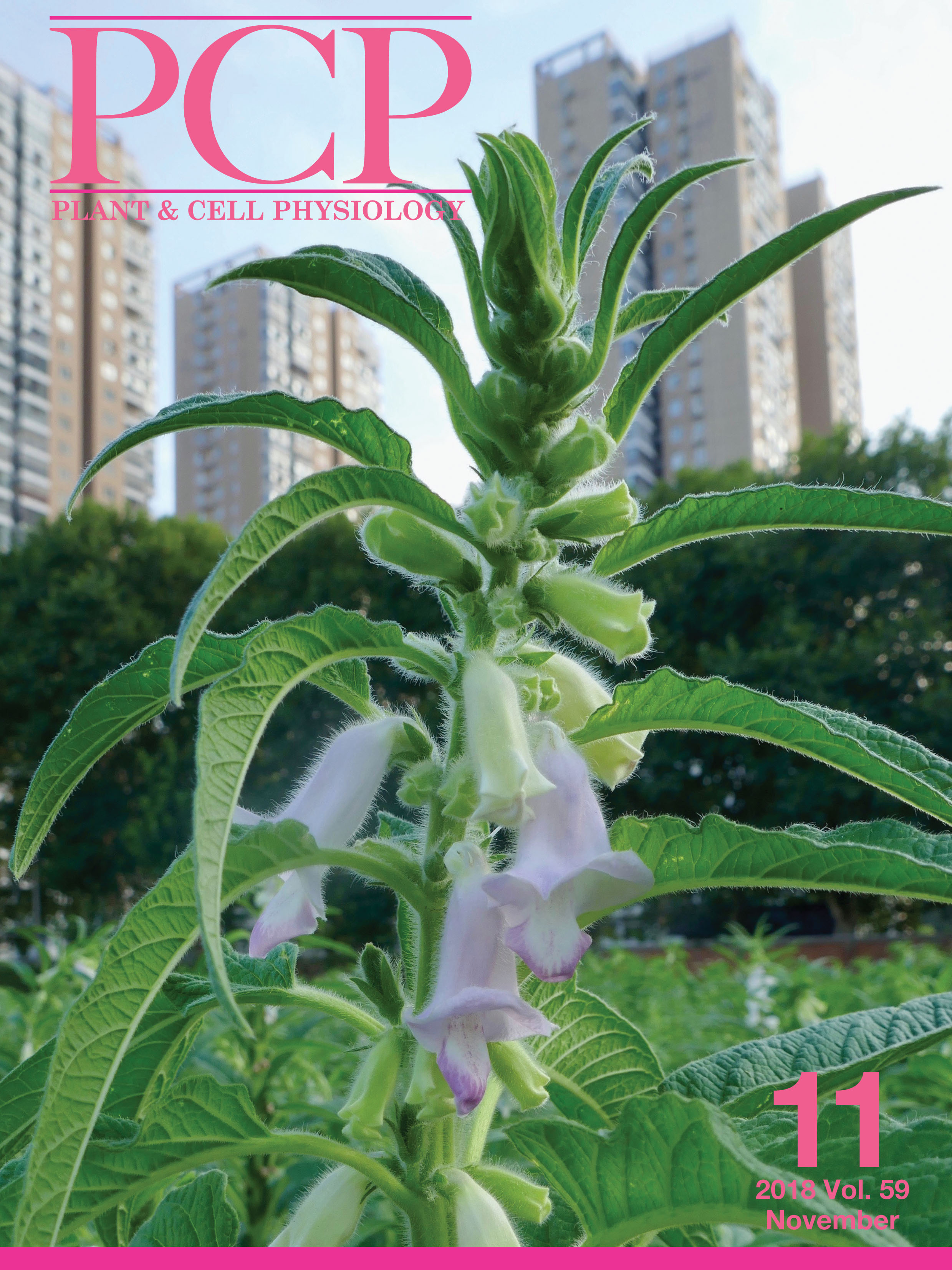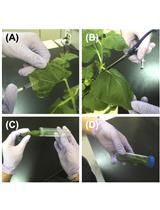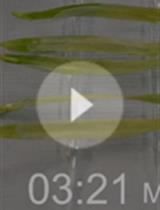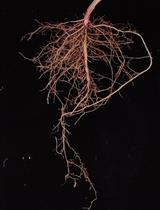- EN - English
- CN - 中文
Top Starch Plating Method for the Efficient Cultivation of Unicellular Red Alga Cyanidioschyzon merolae
高效培养单细胞红藻花青素的顶部淀粉平板法
发布: 2019年02月20日第9卷第4期 DOI: 10.21769/BioProtoc.3172 浏览次数: 6455
评审: Dennis NürnbergMarion EisenhutMaksymilian Zienkiewicz
Abstract
The unicellular red alga Cyanidioschyzon merolae has been used as a model photosynthetic eukaryote for various basic and applied studies, and several of these molecular genetics techniques have been reported. However, there are still improvements to be made concerning the plating method. The conventional plating method often generates diffuse colonies and single colonies cannot be easily isolated. To overcome these problems, we established a novel plating method for C. merolae, making use of melted cornstarch as the use of top agar plating in bacterial genetics. This method improved the formation of defined colonies in at least 4-fold higher efficiency than the conventional method, and made the handling procedure much easier than the previous method.
Keywords: Cyanidioschyzon merolae (红藻)Background
Cyanidioschyzon merolae 10D is a unicellular red alga that inhabits sulfate acid hot springs (Matsuzaki et al., 2004). It has a simple cellular structure, composed of a minimum set of organelles: one nucleus, one mitochondrion, and one plastid in a cell. C. merolae is used as a model organism to investigate the basic architecture of eukaryotes. Thus, many molecular genetics techniques have been developed using this organism, including antisense suppression, transient expression, gene disruption, and stable insertion into the genome (Minoda et al., 2004; Ohnuma et al., 2008; Imamura et al., 2009; Imamura et al., 2010; Zienkiewicz et al., 2017a; Zienkiewicz et al., 2017b; Zienkiewicz et al., 2018). The plating method for the selection of transformants is important for transformation experiments. However, C. merolae shows considerably low plating efficiencies (less than 0.5%) on MA2 solid gellan gum plates. The direct spread of cells onto an MA2 solid gellan gum plate usually results in the death of the cells (Figure 1A). Hence, the plating method has been modified using the cornstarch embedding method which is commonly used for the cell-wall-less Chlamydomonas reinhardtii strain (Shimogawara et al., 1998). In the cornstarch embedding method, cells are grown on a starch bed prepared by spotting 20% slurry cornstarch on the MA2 solid gellan gum. Cells form colonies on the solid starch bed, but these are often diffused or blurred (Figure 1B).
To improve these points, we here devised a novel plating method using melted cornstarch (named in this protocol “top starch solution method”), similar to the top-agar plating method used in bacterial genetics. The 2% cornstarch in dH2O was melted at 98 °C for 10 min. The melted cornstarch solution (= top starch solution) was mixed with an equal volume of the liquid MA2 medium containing C. merolae cells, and poured onto the surface of the MA2 solid gellan gum. Cells formed defined colonies using this plating method (Figure 1C). The plating efficiency of the top starch solution method was more than 2.0%, while that of the conventional method was less than 0.5%. In the conventional method, it was necessary to prepare many starch beds on solid plates prior to use, but the top starch solution method only requires the pouring of the melted starch-cell mixture onto the solid medium, making the plating procedure quick and easy. In this report, we describe the detailed procedure of the top starch solution method.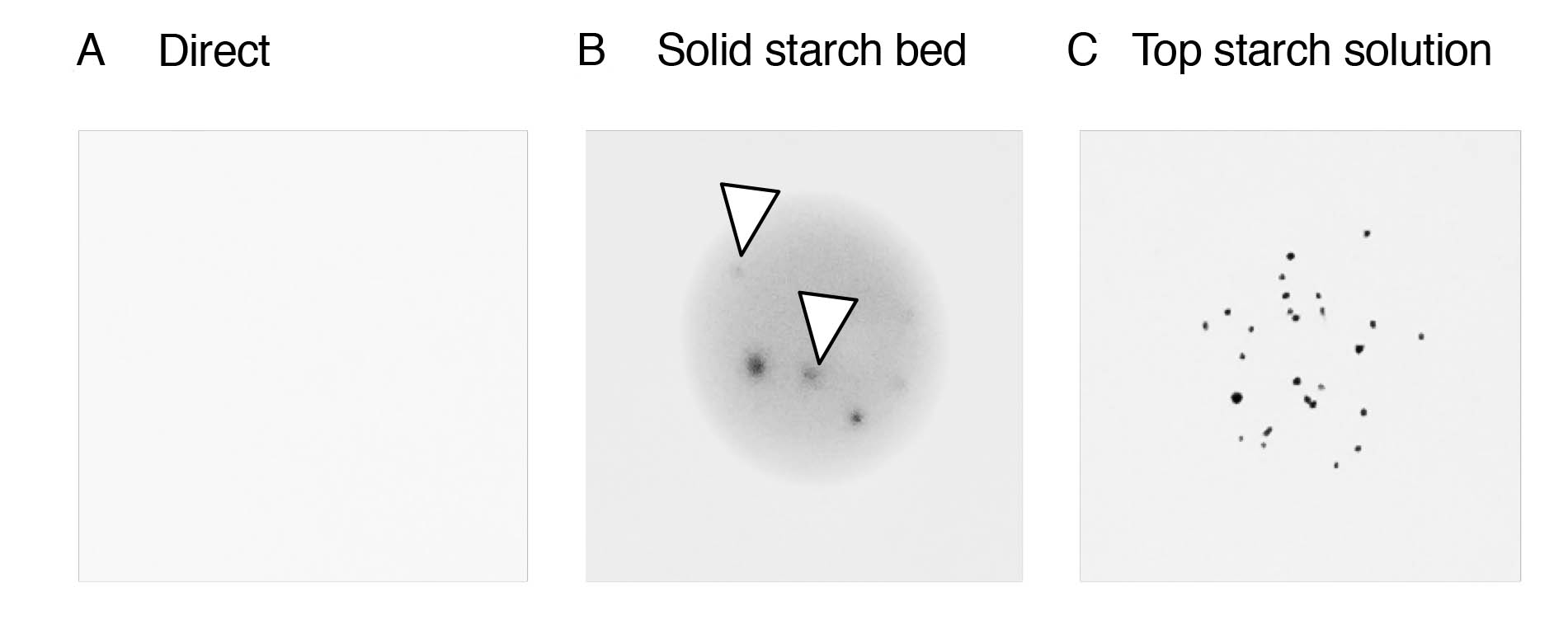
Figure 1. Effect of the top starch solution method on the colony formation in C. merolae. (A-C) In each approach, plates with the spotted cells were incubated for two weeks at 40 °C under continuous white light. A. Five hundred cells were directly spotted onto an MA2 solid gellan gum plate, which resulted in no visible colony formation. B. Solid starch beds were made using 15 μl of 20% slurry cornstarch in an MA2 liquid medium. Five hundred cells were spotted onto a solid cornstarch bed. Open triangles indicate diffused, blurred colonies. C. The 2% cornstarch in dH2O was melted at 98 °C for 10 min to make the top starch solution. The top starch solution was mixed with an equal volume of cells in MA2 medium. Fifteen microliter aliquots containing 500 cells were spotted onto the MA2 solid gellan gum plate.
Materials and Reagents
- Pipette tips (NIPPON Genetics Co., Ltd., catalog numbers: FG-102, FG-301, FG-401)
- Parafilm (LMS Co., Ltd., catalog number: PF, PM-996)
- 1.5 ml microtube (BM Equipment Co., Ltd., catalog number: NT-175)
- 2.0 ml microtube (WATSON Co., Ltd., catalog number: 132-620C)
- 50 ml centrifuge tube (Corning Incorporated., catalog number: 352196)
- AnaeroPouch (Mitsubishi Gas, catalog number: 2-3764-02)
- AnaeroPack (Mitsubishi Gas, catalog number: 2-3765-01)
- Sterilized plastic plate (Ø 90 mm) (As One Corporation., catalog number: GD90-15)
- Cyanidioschyzon merolae 10D [available as NIES-3377 from NIES collection, Tsukuba, Japan (http://mcc.nies.go.jp/index_en.html)]
- Cornstarch (Kawamitsu-Bussan, catalog number: 4901 486 02701 6)
- Gellan gum (FUJIFILM Wako Pure Chemical Corporation, catalog number: 073-03071)
- Uracil (Sigma-Aldrich, catalog number: U0750-5G)
- 5-Fluoroorotic acid monohydrate (5-FOA) (FUJIFILM Wako Pure Chemical Corporation, catalog number: 003234)
- Ethanol (FUJIFILM Wako Pure Chemical Corporation, catalog number: 055-00457)
- (NH4)2SO4 (FUJIFILM Wako Pure Chemical Corporation, catalog number: 019-03435)
- MgSO4∙7H2O (FUJIFILM Wako Pure Chemical Corporation, catalog number: 138-00415)
- H2SO4 (FUJIFILM Wako Pure Chemical Corporation, catalog number: 192-04696)
- H3BO3 (FUJIFILM Wako Pure Chemical Corporation, catalog number: 021-02195)
- MnCl2∙4H2O (FUJIFILM Wako Pure Chemical Corporation, catalog number: 133-00725)
- ZnCl2 (FUJIFILM Wako Pure Chemical Corporation, catalog number: 268-01022)
- Na2MoO4∙2H2O (FUJIFILM Wako Pure Chemical Corporation, catalog number: 198-02471)
- CoCl2∙6H2O (FUJIFILM Wako Pure Chemical Corporation, catalog number: 038-03681)
- CuCl2∙2H2O (FUJIFILM Wako Pure Chemical Corporation, catalog number: 039-04135)
- KH2PO4 (FUJIFILM Wako Pure Chemical Corporation, catalog number: 169-04245)
- CaCl2∙2H2O (FUJIFILM Wako Pure Chemical Corporation, catalog number: 038-19735)
- FeCl3∙6H2O (FUJIFILM Wako Pure Chemical Corporation, catalog number: 090-02802)
- Na2EDTA (FUJIFILM Wako Pure Chemical Corporation, catalog number: 345-01865)
- 20% slurry cornstarch stock solution (see Recipes)
- MA2 medium (Kobayashi et al., 2010) (see Recipes)
- MA2 solution I
- A6 minor salts
- MA2 solution II
- MA2 solution III
- MA2 solution IV
- MA2 solid gellan gum plate (see Recipes)
Equipment
- Pipettes (Gilson, Inc., catalog numbers: F123600, F123601, F123602)
- Refrigerated centrifuge (Koki Holdings Co., Ltd., model: CF16RXII)
- Microcentrifuge (TOMY Seiko Co., Ltd., model: MX150)
- 500 ml flask (IWAI, catalog number: 4442FK500)
- Heat block (Chiyoda Science Co., Ltd., model: MiniT-100)
- Bio incubator (TOMY Seiko Co., Ltd., model: CLE-303)
- Clean bench (Panasonic Healthcare Co., Ltd., model: MCV-131BNF)
- Vortex mixer (M & S Instruments Inc., model: SI-0286)
- Sterile filter (Ø 0.22 μm, Merck, catalog number: SLGV033RS)
Procedure
文章信息
版权信息
© 2019 The Authors; exclusive licensee Bio-protocol LLC.
如何引用
Takemura, T., Kobayashi, Y., Imamura, S. and Tanaka, K. (2019). Top Starch Plating Method for the Efficient Cultivation of Unicellular Red Alga Cyanidioschyzon merolae. Bio-protocol 9(4): e3172. DOI: 10.21769/BioProtoc.3172.
分类
植物科学 > 藻类学 > 细胞分离与培养
细胞生物学 > 细胞分离和培养 > 细胞分离
您对这篇实验方法有问题吗?
在此处发布您的问题,我们将邀请本文作者来回答。同时,我们会将您的问题发布到Bio-protocol Exchange,以便寻求社区成员的帮助。
Share
Bluesky
X
Copy link




